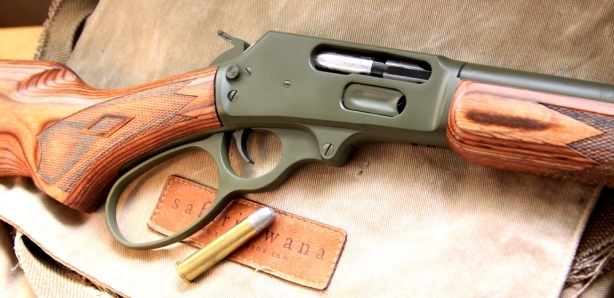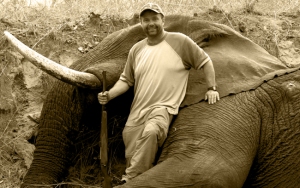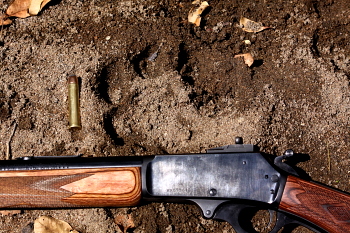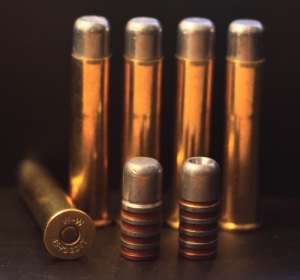When I started shooting the Marlin 1895 Guide Gun I naturally overlooked some obvious off the shelf “factory faults” which only became apparent and were confirmed by reading other Marlin owners gripes and experiences with the new version of the famous Marlin brand aptly named Remlins,
My first goal was to use and test the 45/70 guide gun for use in the field in Africa and I went through a good number of optimum bullet set ups for the 45/70 in Guide Gun form which proved suitable to use in Africa on Dangerous game as well as general everyday plains animals.
Both the Hardcast lead bullets over 430 grains proved formidable for penetration on thick skinned dangerous game as well as the modern machined monolithic solids from NorthFork Technologies and the Hydrostatically stabilised solids from Woodleigh – but you can read about them elsewhere on this blog as I have dedicated separate pages to this quest.
After hunting with my Marlin levergun for 3 seasons in Mozambique and Zambia, the next objective was setting up an off the shelf 1895 Guide Gun (remlin version) – the GBL’s and SBL’s for the African bush. Don’t get the wrong idea, I’d already walked and stalked the African wilderness with the standard off the shelf unmodified Marlin GBL and my current SBL, yet because I am a firm believer in this rifle as a great carrying gun for Africa, I decided to look at the “fixes and set up’s” I could do to make the much talked about ‘Remlins’ the perfect PH gun for the African field.
Now don’t start the argument about this being unsuitable for Africa – I already proved a Cape Buffalo is no match for this rifle – this then makes it suitable as a compliment and versatile addition to the arsenal of any African PH or African safari goer for that matter and NO I would not recommend you chase after angry wounded pachyderms with it either. Given the price to punch ratio, the 1895 GBL & SBL is in my opinion an excellent carrying rifle for the general field work most of us PH’s endure each season and deserves a new look from us sceptical know it all African PH’s.
ALSO,PLEASE gents, lets put Taylors definitive book into context – it was written beyond 30 years ago by a fellow that preferred the expensive British cartridges, not the cowboy classic, shooting an array of ammunition manufactured at that time, of which Kynoch was probably the best, which is not saying much. The world has moved on since then, we have moved on gents and as technology has moved at light speed, so too has bullet quality, design and loading techniques as well as powder and primer design.
Since bringing this gun to Africa, I have continued to be impressed by both the caliber and the complete package – especially the fact that I can get roughly 1600 fps shooting a 525gr Hardcast lead bullet – without a doubt that is and does give anything trying to get at you, a serious punch and penetrates more than necessary.
The Remlins
I entered the levergun market post the Remington / Marlin buyout that I soon discovered everyone was talking and complaining about – I had bought an off the shelf Marlin GBL and yes it was slightly rough and yes, the front sights were off center and the trigger was way too hard and the rear buckhorn sights flew off after a couple of bouts at the range – I’m still looking for it at each target change!
Yet one thing that I liked about the GBL was the robust feel and ‘big gun’ temperament it gave you while holding and shooting it, clearly capable of serious things, one simply had to overlook the initial quality gremlins that many seem to come with. For the price – $595 at that time, I thought it not a big deal to simply fix up the various so called problems. The Marlins have a reputation for accuracy, and while the classic Winchester actions are more robust and usually always much smoother from the start, the Marlins certainly are a popular choice.
Thankfully, as a first time Marlin Levergun owner I had plenty of literature, advice and encouragement to draw from while visiting the popular Marlin Owners Forum. Here I gained much of the necessary information and home fixes that helped iron out – over a period of time – the Remlin gremlins.
NOTE: there have been a number of complaints about cracks in the metal where the barrel and receiver meet which is not visible to the naked eye unless you take the rifle apart and remove the magazine tube. This issue seems to be apparent in the 1895’s chambered in 45-70 caliber and can be a very serious and dangerous fault. I highly recommend you join the Marlin owners website and learn how to ‘take down’ and re assemble your 1895 and regularly check for any faults or visible defects.
Up to Speed
The obvious issues I encountered with the GBL as well as other suggested ‘fixes’ were:
– front sight off centre & generally shoddy iron sights set up
– rough and stiff action when pumping the lever
– sharp edges on loading gate and action parts
– hard firm trigger
– two piece ejector prone to breaking
– screws keep working loose under heavy fire
All of these are pretty easy fixes if you have a basic understanding of how to follow instructions and use a screwdriver! Seriously, there is no rocket science when it comes to taking the levergun apart and reassembly especially with the instructions on the Marlin Owners Forum. Instead of buying one of the customized Marlins from Wild West or Grizzly Custom ( these are magnificent guns and I wish I could afford them ALL) there are a few inexpensive and easy to DIY fixes and additions you can dress your Marlin GBL up with.
As I have tested the Marlin 1895 in the field in Africa, these are the suggested fixes and changes I made to my levergun before I departed for the dark continent.
Marlin Sights
OK, the new Remlins have a shoddy iron sights system, the back sight flies off if you shoot heavy loads and the front sight on many does tend to lean to one side although if you remove the front sight hood then it is not that apparent and the gun still shoots straight. However the solace is this: if you are a proud Marlin owner, you’re going to replace the iron sights anyway, be it with a scope or one of the red dot or holographic offerings OR better still open or iron sights So don’t stress too much about the sights unless you’re a PH like me who makes his living off shooting with an open iron sight at fast biting creatures!
Us African PH’s are used to those very wide flat rear express sights, the kind they used to put on the fancy English doubles when rifles were a luxury and we have grown up to snap shoot with those since knee high. Yet most of the American folks tend to think Peep sights when you mention iron sights and this is what I started out trying – namely the offerings from the folks at Skinner Sights – an excellent line up of levergun as well as other rifle peep sights. What I liked about Skinner was the genuine hand made feel of their machined sights and each one felt perfectly balanced. At first I opted for a sight mounted on the 2 rear receiver screw holes sitting closer to your eye when aiming – I left the front sight the same.
This is where the next problem arose! Shooting the heavier bullets (400 plus grains) I kept hitting the target extremely low and could not adjust the sights any further to reach a higher level. Solution was to lower the front sight – and this turned out a little testy and required me buying a whole set of different front sights to try out – most of which did not work out.
Skinner sell sight sets with the front sight being adjustable by filing it down to suit your rifles particular needs and that is what I suggest. Having a recent look at the Skinner website I noticed a new front winged sight offering for the 1895 which is meant to be combined with a rear winged site as well – this looks like the correct set up and I have one on order.
On my next Marlin, a shiny stainless SBL, I tried Skinners barrel mounted peep sight which worked extremely well, yet still I had the issue with the front sight being too high. From my past experience I tried a new approach, a new stainless front sight ramp which I manually drilled and fixed with a smaller sized shotgun bead and this turned out to be perfect – the ramp itself was slightly lower then the original and this made the difference. What I learned here was that it was very much a scenario of self judgement and trial and error to get the iron sights into synch and it will differ from shooter to shooter.
The best bet here is to buy your peep sights as a complete set rather than trying to save with just the rear aperture sets. Skinner and XS Sights make excellent systems and although a little expensive they do stand a breed apart. If you buy the complete set, these manufacturers have usually taken the various height and sighting issue into account so it is a simple install.
Looking at the variations of rails (piccatinny style) available to mount on top of the receiver and barrel, something which I have only recently had a close look at, I would suggest this route with a solid Red dot or holographic sight OR a nice scope mounted either to the rail or with stand alone scope mounts. I chose the Game Reaper mounts from DNZ Products with a wide angle Leupold 1.5 – 20 scope mounted on my Wild West Guns co pilot. This is the rifle that incidentally took down the Cape Buffalo in Mozambique in 2012!
For Africa, the short Marlin GBL and SBL leverguns still remain a Point Blank Range performer and this to me is the reason I prefer to stick with those very wide express sights. HOWEVER you have to remember that my job is to protect my clients and that usually means from animals that get too close with an intent on harm.
For the regular Safari client, I suggest a decent wide angle scope, the 1895 handles very well with a scope and remember, just because I am talking about the short guide guns, it does not mean you have to follow suit. Marlin have the 1895XLR series and the 1895 classics which have barrels from 22 – 24 inches making them feel more like a regular bolt action rifle. It is these guns, mounted with prudent optics that are already a perfect choice for Africa – without a doubt and I find it hard to believe that nobody has had the sense to see this.
One of the problems I encountered with the Guide Guns (and most of my other guns that I use religiously) is that the bluing wears off after a season, especially on the lever itself and then also around the front end of the receiver as this is the most comfortable place to hold the rifle. Typically I do not baby a gun while hunting, it is a tool I use and made for the purpose of protection.
Recently I discovered DuraCoat firearm finishes from Lauer Weaponry and must admit that I have been suitably impressed at the way this coating is easily applied and transforms the look of the guide guns. Their service is fast, they have a multitude of colors and application is very simple and inexpensive – believe me, if a PH from Africa can do it, then anyone can!
What I found easier was the relative simplicity of the Marlin GBL levergun design and its dis-assembly making the application of DuraCoat straight forward and easy for the novice to do. With a $120 airbrush kit from Harbor Freight, I transformed my tired and fading 1895 into a weapon of great beauty and versatility!
OK so if you’re not going to use your levergun to the extent that I do, then keep it holed up in a soft case and clean it each night and forget about DuraCoat, but if you’re going to pull it through the brush and dirt as I do, then this is a great way to renew your old beat up Levergun.








